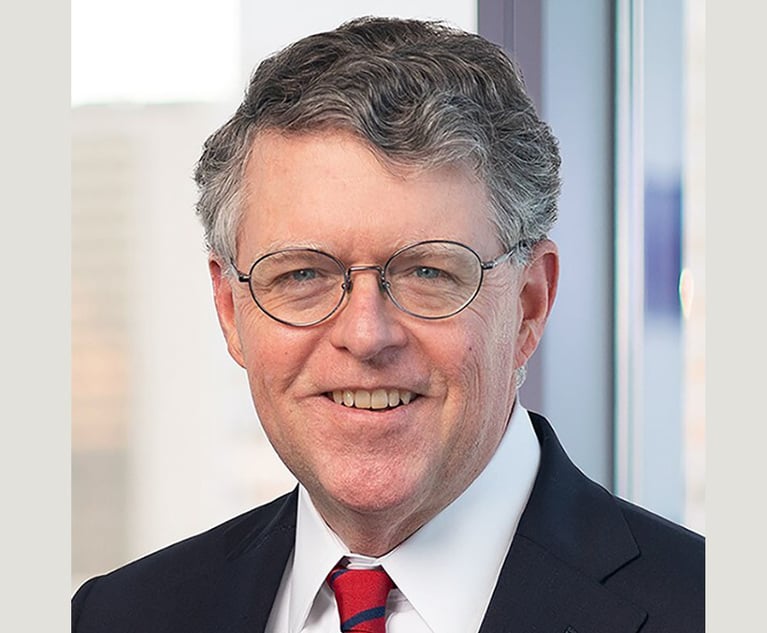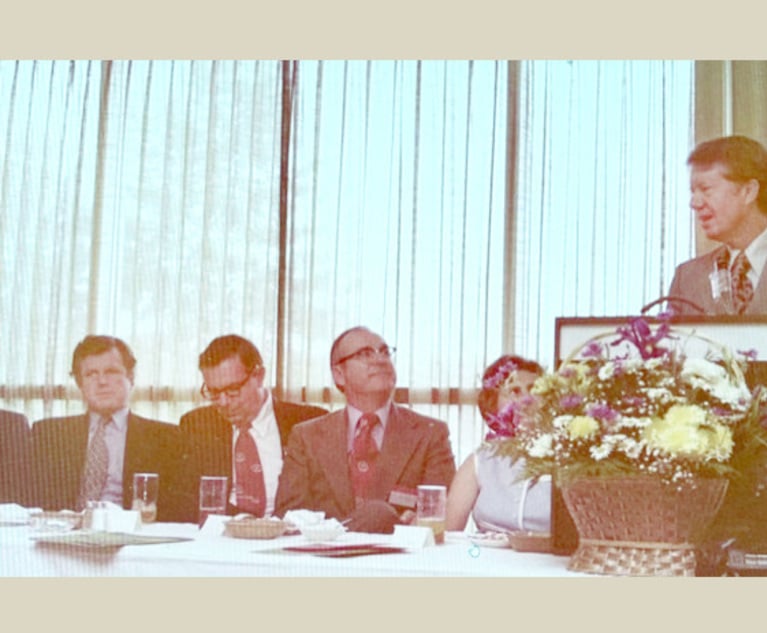Ahead of the Supreme Court's First Telephonic Arguments, Some Tips From the Trenches
Morrison & Foerster's Joseph Palmore recently argued his first telephonic oral argument before the highest court in Massachusetts. He shares his thoughts on what makes a successful session.
April 16, 2020 at 11:29 AM
6 minute read

The U.S. Supreme Court announced this week that it will hold oral arguments in May by teleconference and that "[d]etails will be shared as they become available." Those details matter—they'll help determine whether the Court's pandemic-forced innovation will succeed.
I argued an appeal by phone last week. That gives me exactly one more such argument than many appellate lawyers—who, like me until very recently, have done zero. That doesn't make me an expert, but my experience has led to thoughts on how the Supreme Court can make the best of this format.
First a bit of background. I argued before the Massachusetts Supreme Judicial Court, the commonwealth's highest court. Like the U.S. Supreme Court, it's hearing arguments by phone. And the Massachusetts court has seven justices, which makes it similar in size to the U.S. Supreme Court. All of this means the Supreme Judicial Court is something of a test case for the justices and court officers now planning the Supreme Court's phone arguments.
The Supreme Judicial Court follows this standard format for its phone arguments:
First, each advocate gets three minutes at the start of their time to speak without interruption.
Second, justices are recognized in descending order of seniority by the chief justice to ask their questions. The chief justice goes last. After one full round, the chief asks the justices if they have any additional questions.
Third, while each side still has a formal time limit of 15 minutes, no buzzer or chime marks it. Allowing each justice to ask questions in turn (with a second round when necessary) means that many of the arguments have gone over time.
Fourth, the argument audio is live-streamed to the general public.
The Clerk for the Commonwealth Fran Kenneally and his excellent team clearly communicated this format to advocates in advance. The chief justice then reiterated it at the start of each argument.
The U.S. Supreme Court's prior practices and already-announced plans mirror some of this. The Supreme Court recently began allowing advocates two minutes of uninterrupted time to open their arguments. And the high court has already announced it will livestream the audio of its telephone arguments. A first for the court, livestreaming is a welcome move in favor of public access to its work.
The main challenge of telephone arguments at the Supreme Court will be justices' questioning. A typical Supreme Court argument can be like an 8-on-1 game of ping-pong, in which advocates answer questions in rapid succession from different, often-interrupting Justices. (It's 8-on-1 instead of 9-on-1 because Justice Clarence Thomas is famously silent during oral argument.)
That free-for-all, rapid-fire mode of argument may be ill-suited to a teleconference. Some federal courts of appeals, like the Federal Circuit, have allowed judges to ask questions in the ordinary, unstructured way during phone arguments without much problem. But what works for a three-judge panel may be unwieldy for a nine-Justice Supreme Court.
Anyone who has participated in a large conference call knows how common it is for people to talk over each other, awkwardly pause and then do it again. The slight time lag on the phone and the inability to see visual cues that someone is about to speak can make for a frustrating conversation. Those difficulties are compounded when multiple people are eagerly trying to interject or disagree—people like the justices at a typical argument.
Another problem with attempting the court's traditional, freewheeling approach on the phone would be identifying which Justice is speaking. Veteran court observers may be able to guess a questioning Justice by voice, but first-time advocates and members of the public may not.
One solution would be to follow the Supreme Judicial Court's approach of having justices ask questions in seniority order. That would avoid cross-talk and limit interruptions. It would also allow participants and listeners to identify a justice who speaks because the chief justice would have called on them. But that format would not allow Justices to easily follow up on other Justices' questions, as often happens in live arguments.
If the court prefers a less-rigid approach, it could use a hybrid system. Justices could notify the chief justice by email that they have a question, allowing him to call on each in turn. The chief could use this air traffic-control power to spread questions equitably, identify each speaking justice by name and keep the arguments roughly within their assigned time limits.
On the other side of the equation are the advocates who will argue by phone in May. From the attorney's perspective, what is different about presenting argument by phone? Not much actually. Whether in person, over the phone or on video, the oral advocate's goals are the same: Make the important affirmative points, directly answer questions and know the record and relevant law cold.
To prepare for my phone argument, I had the same kind of moot courts as always. I did the "in-role" portion telephonically to simulate the coming argument, followed by a debrief session on video. I also made the same kind of argument outline I always do. But, just as I never look at an outline during an in-person argument, I did not do so during the phone argument, preferring natural conversation to reading.
A final word on technology and the need for testing. During my argument, audible static could be heard on my line when I spoke, likely due to storms moving through Washington, D.C., at the time. The high court should consider a pre-argument audio check, in which advocates and justices can call in, test sound quality and ensure a good connection.
I commend the court for proceeding with oral arguments. With careful planning and communication, its telephone sessions will be successful. And they will provide the public valuable access to a part of their government that has shown admirable flexibility in proceeding with its business in these difficult times.
Joseph Palmore is co-chair of the appellate and Supreme Court practice group at Morrison & Foerster. He has argued 12 cases before the U.S. Supreme Court, including two this term.
This content has been archived. It is available through our partners, LexisNexis® and Bloomberg Law.
To view this content, please continue to their sites.
Not a Lexis Subscriber?
Subscribe Now
Not a Bloomberg Law Subscriber?
Subscribe Now
NOT FOR REPRINT
© 2025 ALM Global, LLC, All Rights Reserved. Request academic re-use from www.copyright.com. All other uses, submit a request to [email protected]. For more information visit Asset & Logo Licensing.
You Might Like
View All
Switching Positions: US Solicitors General and Climate Change Lawsuits
6 minute read
Jimmy Carter’s 1974 Law Day Speech: A Call for Lawyers to Do the Public Good
14 minute readLaw Firms Mentioned
Trending Stories
- 1Judge Largely Blocks Tennessee's Porn Site Age Verification Law as Other States Enforce Theirs
- 2Divorce Timing Is Everything: Waiting for the New Year May Have Its Advantages
- 3Bracewell Adds Former Pioneer Natural Resources Lawyer to O&G, Energy Transition Practices
- 4Send Us Your New Partners for The Legal's 2025 New Partners Yearbook
- 5Another US Firm Shutters London Office
Who Got The Work
Michael G. Bongiorno, Andrew Scott Dulberg and Elizabeth E. Driscoll from Wilmer Cutler Pickering Hale and Dorr have stepped in to represent Symbotic Inc., an A.I.-enabled technology platform that focuses on increasing supply chain efficiency, and other defendants in a pending shareholder derivative lawsuit. The case, filed Oct. 2 in Massachusetts District Court by the Brown Law Firm on behalf of Stephen Austen, accuses certain officers and directors of misleading investors in regard to Symbotic's potential for margin growth by failing to disclose that the company was not equipped to timely deploy its systems or manage expenses through project delays. The case, assigned to U.S. District Judge Nathaniel M. Gorton, is 1:24-cv-12522, Austen v. Cohen et al.
Who Got The Work
Edmund Polubinski and Marie Killmond of Davis Polk & Wardwell have entered appearances for data platform software development company MongoDB and other defendants in a pending shareholder derivative lawsuit. The action, filed Oct. 7 in New York Southern District Court by the Brown Law Firm, accuses the company's directors and/or officers of falsely expressing confidence in the company’s restructuring of its sales incentive plan and downplaying the severity of decreases in its upfront commitments. The case is 1:24-cv-07594, Roy v. Ittycheria et al.
Who Got The Work
Amy O. Bruchs and Kurt F. Ellison of Michael Best & Friedrich have entered appearances for Epic Systems Corp. in a pending employment discrimination lawsuit. The suit was filed Sept. 7 in Wisconsin Western District Court by Levine Eisberner LLC and Siri & Glimstad on behalf of a project manager who claims that he was wrongfully terminated after applying for a religious exemption to the defendant's COVID-19 vaccine mandate. The case, assigned to U.S. Magistrate Judge Anita Marie Boor, is 3:24-cv-00630, Secker, Nathan v. Epic Systems Corporation.
Who Got The Work
David X. Sullivan, Thomas J. Finn and Gregory A. Hall from McCarter & English have entered appearances for Sunrun Installation Services in a pending civil rights lawsuit. The complaint was filed Sept. 4 in Connecticut District Court by attorney Robert M. Berke on behalf of former employee George Edward Steins, who was arrested and charged with employing an unregistered home improvement salesperson. The complaint alleges that had Sunrun informed the Connecticut Department of Consumer Protection that the plaintiff's employment had ended in 2017 and that he no longer held Sunrun's home improvement contractor license, he would not have been hit with charges, which were dismissed in May 2024. The case, assigned to U.S. District Judge Jeffrey A. Meyer, is 3:24-cv-01423, Steins v. Sunrun, Inc. et al.
Who Got The Work
Greenberg Traurig shareholder Joshua L. Raskin has entered an appearance for boohoo.com UK Ltd. in a pending patent infringement lawsuit. The suit, filed Sept. 3 in Texas Eastern District Court by Rozier Hardt McDonough on behalf of Alto Dynamics, asserts five patents related to an online shopping platform. The case, assigned to U.S. District Judge Rodney Gilstrap, is 2:24-cv-00719, Alto Dynamics, LLC v. boohoo.com UK Limited.
Featured Firms
Law Offices of Gary Martin Hays & Associates, P.C.
(470) 294-1674
Law Offices of Mark E. Salomone
(857) 444-6468
Smith & Hassler
(713) 739-1250












